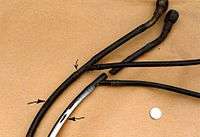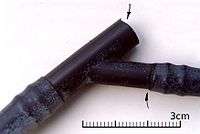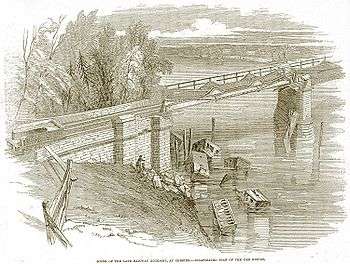Forensic engineering
| Forensic science |
|---|
 |
| Physiological sciences |
| Social sciences |
| Forensic criminalistics |
| Digital forensics |
| Related disciplines |
| Related articles |
Forensic engineering is the investigation of materials, products, structures or components that fail or do not operate or function as intended, causing personal injury or damage to property. The consequences of failure are dealt with by the law of product liability. The field also deals with retracing processes and procedures leading to accidents in operation of vehicles or machinery. The subject is applied most commonly in civil law cases, although it may be of use in criminal law cases. Generally, the purpose of a forensic engineering investigation is to locate cause or causes of failure with a view to improve performance or life of a component, or to assist a court in determining the facts of an accident. It can also involve investigation of intellectual property claims, especially patents.
History
As the field of engineering has evolved over time, so has the field of forensic engineering. Early examples include investigation of bridge failures such as the Tay rail bridge disaster of 1879 and the Dee bridge disaster of 1847. Many early rail accidents prompted the invention of tensile testing of samples and fractography of failed components.[1]
Investigation
Vital to the field of forensic engineering is the process of investigating and collecting data related to the materials, products, structures or components that failed. This involves inspections, collecting evidence, measurements, developing models, obtaining exemplar products, and performing experiments. Often testing and measurements are conducted in an Independent testing laboratory or other reputable unbiased laboratory.
Analysis
Failure mode and effects analysis (FMEA) and fault tree analysis methods also examine product or process failure in a structured and systematic way, in the general context of safety engineering. However, all such techniques rely on accurate reporting of failure rates, and precise identification, of the failure modes involved.
There is some common ground between forensic science and forensic engineering, such as scene of crime and scene of accident analysis, integrity of the evidence and court appearances. Both disciplines make extensive use of optical and scanning electron microscopes, for example. They also share common use of spectroscopy (infrared, ultraviolet, and nuclear magnetic resonance) to examine critical evidence. Radiography using X-rays (such as X-ray computed tomography), or neutrons is also very useful in examining thick products for their internal defects before destructive examination is attempted. Often, however, a simple hand lens may reveal the cause of a particular problem.
Trace evidence is sometimes an important factor in reconstructing the sequence of events in an accident. For example, tire burn marks on a road surface can enable vehicle speeds to be estimated, when the brakes were applied and so on. Ladder feet often leave a trace of movement of the ladder during a slipaway, and may show how the accident occurred. When a product fails for no obvious reason, SEM and Energy-dispersive X‑ray spectroscopy (EDX) performed in the microscope can reveal the presence of aggressive chemicals that have left traces on the fracture or adjacent surfaces. Thus an acetal resin water pipe joint suddenly failed and caused substantial damages to a building in which it was situated. Analysis of the joint showed traces of chlorine, indicating a stress corrosion cracking failure mode. The failed fuel pipe junction mentioned above showed traces of sulfur on the fracture surface from the sulfuric acid, which had initiated the crack.
Extracting physical evidence from digital photography is a major technique used in forensic accident reconstruction. Camera matching, photogrammetry, and photo rectification techniques are used to create three-dimensional and top-down views from the two-dimensional photos typically taken at an accident scene. Overlooked or undocumented evidence for accident reconstruction can be retrieved and quantified as long as photographs of such evidence are available. By using photographs of the accident scene including the vehicle, "lost" evidence can be recovered and accurately determined.[2]
Forensic materials engineering involves methods applied to specific materials, such as metals, glasses, ceramics, composites and polymers.
Examples



The broken fuel pipe shown at left caused a serious accident when diesel fuel poured out from a van onto the road. A following car skidded and the driver was seriously injured when she collided with an oncoming lorry. Scanning electron microscopy or SEM showed that the nylon connector had fractured by stress corrosion cracking (SCC) due to a small leak of battery acid. Nylon is susceptible to hydrolysis when in contact with sulfuric acid, and only a small leak of acid would have sufficed to start a brittle crack in the injection moulded nylon 6,6 connector by SCC. The crack took about 7 days to grow across the diameter of the tube. The fracture surface showed a mainly brittle surface with striations indicating progressive growth of the crack across the diameter of the pipe. Once the crack had penetrated the inner bore, fuel started leaking onto the road.
The nylon 6,6 had been attacked by the following reaction, which was catalyzed by the acid:
Diesel fuel is especially hazardous on road surfaces because it forms a thin, oily film that cannot be easily seen by drivers. It is much like black ice in its slipperiness, so skids are common when diesel leaks occur. The insurers of the van driver admitted liability and the injured driver was compensated.
Applications
Most manufacturing models will have a forensic component that monitors early failures to improve quality or efficiencies. Insurance companies use forensic engineers to prove liability or nonliability. Most engineering disasters (structural failures such as bridge and building collapses) are subject to forensic investigation by engineers experienced in forensic methods of investigation. Rail crashes, aviation accidents, and some automobile accidents are investigated by forensic engineers in particular where component failure is suspected. Furthermore, appliances, consumer products, medical devices, structures, industrial machinery, and even simple hand tools such as hammers or chisels can warrant investigations upon incidents causing injury or property damages. The failure of medical devices is often safety-critical to the user, so reporting failures and analysing them is particularly important. The environment of the body is complex, and implants must both survive this environment, and not leach potentially toxic impurities. Problems have been reported with breast implants, heart valves, and catheters, for example.
Failures that occur early in the life of a new product are vital information for the manufacturer to improve the product. New product development aims to eliminate defects by testing in the factory before launch, but some may occur during its early life. Testing products to simulate their behavior in the external environment is a difficult skill, and may involve accelerated life testing for example. The worst kind of defect to occur after launch is a safety-critical defect, a defect that can endanger life or limb. Their discovery usually leads to a product recall or even complete withdrawal of the product from the market. Product defects often follow the bathtub curve, with high initial failures, a lower rate during regular life, followed by another rise due to wear-out. National standards, such as those of ASTM and the British Standards Institute, and International Standards can help the designer in increasing product integrity.
Historic examples
There are many examples of forensic methods used to investigate accidents and disasters, one of the earliest in the modern period being the fall of the Dee bridge at Chester, England. It was built using cast iron girders, each of which was made of three very large castings dovetailed together. Each girder was strengthened by wrought iron bars along the length. It was finished in September 1846, and opened for local traffic after approval by the first Railway Inspector, General Charles Pasley. However, on 24 May 1847, a local train to Ruabon fell through the bridge. The accident resulted in five deaths (three passengers, the train guard, and the locomotive fireman) and nine serious injuries. The bridge had been designed by Robert Stephenson, and he was accused of negligence by a local inquest.
Although strong in compression, cast iron was known to be brittle in tension or bending. On the day of the accident, the bridge deck was covered with track ballast to prevent the oak beams supporting the track from catching fire, imposing a heavy extra load on the girders supporting the bridge and probably exacerbating the accident. Stephenson took this precaution because of a recent fire on the Great Western Railway at Uxbridge, London, where Isambard Kingdom Brunel's bridge caught fire and collapsed.
One of the first major inquiries conducted by the newly formed Railway Inspectorate was conducted by Captain Simmons of the Royal Engineers, and his report suggested that repeated flexing of the girder weakened it substantially. He examined the broken parts of the main girder, and confirmed that the girder had broken in two places, the first break occurring at the center. He tested the remaining girders by driving a locomotive across them, and found that they deflected by several inches under the moving load. He concluded that the design was flawed, and that the wrought iron trusses fixed to the girders did not reinforce the girders at all, which was a conclusion also reached by the jury at the inquest. Stephenson's design had depended on the wrought iron trusses to strengthen the final structures, but they were anchored on the cast iron girders themselves, and so deformed with any load on the bridge. Others (especially Stephenson) argued that the train had derailed and hit the girder, the impact force causing it to fracture. However, eyewitnesses maintained that the girder broke first and the fact that the locomotive remained on the track showed otherwise.
Publications
Product failures are not widely published in the academic literature or trade literature, partly because companies do not want to advertise their problems. However, it then denies others the opportunity to improve product design so as to prevent further accidents. However, a notable exception to the reluctance to publish is the journal Engineering Failure Analysis, which publishes case studies of a wide range of different products, failing under different circumstances. There are also an increasing number of textbooks becoming available.
Another notable publication, dealing with failures of buildings, bridges, and other structures, is the Journal of Performance of Constructed Facilities,[3] which is published by the American Society of Civil Engineers, under the umbrella of its Technical Council on Forensic Engineering.[4]
See also
References
- ↑ Smith, Cyril Stanley (1988) [1960]. A History Of Metallography: The Development Of Ideas On The Structure Of Metals Before 1890. MIT Press. ISBN 9780262691208.
- ↑ Extracting Physical Evidence from Digital Photographs for use in Forensic Accident Reconstruction, David Danaher, P.E., Jeff Ball, Ph.D., P.E., and Mark Kittel, P.E, 6-15-12.
- ↑ Scitation.aip.org
- ↑ tcfe.asce.org/
Further reading
- Introduction to Forensic Engineering (The Forensic Library) by Randall K. Noon, CRC Press (1992).
- Forensic Engineering Investigation by Randall K. Noon, CRC Press (2000).
- Forensic Materials Engineering: Case Studies by Peter Rhys Lewis, Colin Gagg, Ken Reynolds, CRC Press (2004).
- Peter R Lewis and Sarah Hainsworth, Fuel Line Failure from stress corrosion cracking, Engineering Failure Analysis,13 (2006) 946-962...
| Wikimedia Commons has media related to Forensic science. |
- National Academy of Forensic Engineers
- "Introduction to Forensic Engineering". OpenLearn. Open University.
- Forensic (Structural) Engineering
- Journals
- The Journal Engineering Failure Analysis
- "Forensic Engineering". Proceedings of the ICE.

